Note: Measurements taken in the anechoic chamber at Canada's National Research Council can be found through this link.
 This review is the latest in a series of events that began in December 2014, when I was invited to Devialet’s headquarters, in Paris, France, for a private presentation of the Phantom ($3980 USD/pair) and Silver Phantom ($4780/pair) loudspeakers. Devialet was then so secretive about these models that their marketing director at first forbade me from photographing them. After a brief standoff, we agreed that I would cover them that month in a blog on SoundStage! Global. That blog proved immensely popular -- it was the world’s first detailed look at this drastically new loudspeaker concept. But it spawned controversies that continue to this day.
This review is the latest in a series of events that began in December 2014, when I was invited to Devialet’s headquarters, in Paris, France, for a private presentation of the Phantom ($3980 USD/pair) and Silver Phantom ($4780/pair) loudspeakers. Devialet was then so secretive about these models that their marketing director at first forbade me from photographing them. After a brief standoff, we agreed that I would cover them that month in a blog on SoundStage! Global. That blog proved immensely popular -- it was the world’s first detailed look at this drastically new loudspeaker concept. But it spawned controversies that continue to this day.
The Phantoms’ official launch at the January 2015 Consumer Electronics Show rankled many audiophiles and journalists, for various reasons. There were marketing images that showed a woman clothed only in a sheer gown and a man smoking a cigarette in a burned-out room -- no problem in France, but controversial in more conservative parts of the world. Another was the radical industrial design -- the Phantoms looked less like speakers than giant Tylenol capsules. Worst was Devialet’s ad copy, which included such silly terms as Heart Bass Implosion, and made the impossible claim -- especially for a loudspeaker -- of “zero distortion.” In response, many audiophiles, including some of our own writers, dismissed the Phantoms without even listening to them.
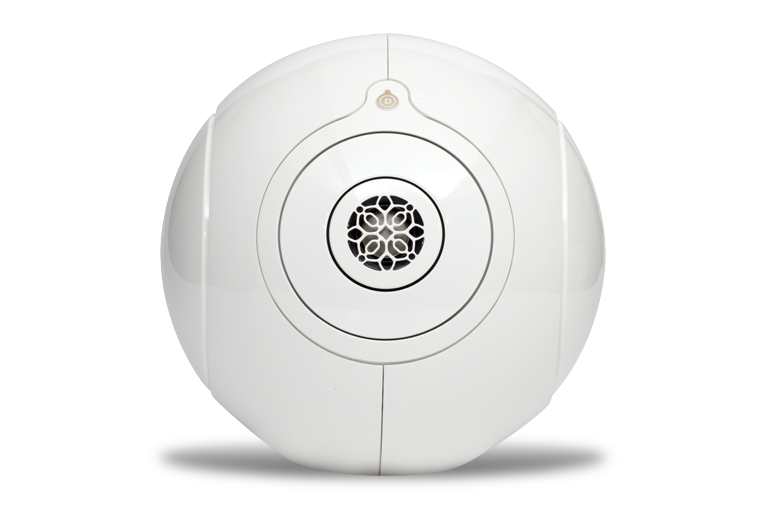
Thankfully, Hans Wetzel listened. In February 2016, Hans reviewed the Silver Phantoms for SoundStage! Access, loved them, and still talks about them today. Nor have I ever forgotten what I saw and heard in France three years ago -- which is why I was happy to receive Devialet’s newest model, the Gold Phantom ($5980/pair), for a full review.
Description
All three Phantom models are built on the same innovative platform. They’re constructed around a cast-aluminum spine that runs front to back, directly through the middle of the enclosure. This aluminum piece adds tremendous strength to the structure, provides an armature on which to mount the electronics and the four drivers, and divides the inside of the enclosure into three chambers: a small one toward the front, for the concentric midrange-tweeter driver; and two much larger ones behind, for the woofers.
Surrounding the spine is the outer enclosure, a capsule-shaped, flat-sided, shell made from an outer skin of ABS plastic and an inner skin of glass-fiber-filled polycarbonate. The Gold Phantom is white -- no other shades or colors are available at present. Its composite skin is formed into two half shells, each about 1/8” thick. Devialet says that robots join the two halves with a pressure of 1.2 tons, to ensure that the enclosure is hermetically sealed. This is important, because each Phantom is a sealed box with no port or other opening. There are a heatsink for the electronics, Ethernet and TosLink inputs, a reset button, and an IEC-compatible inlet for the power cord. There is no on/off switch -- once plugged in, the speaker is always on, and remains in standby mode until it detects a signal at one of its inputs, at which point it instantly goes into full operation.
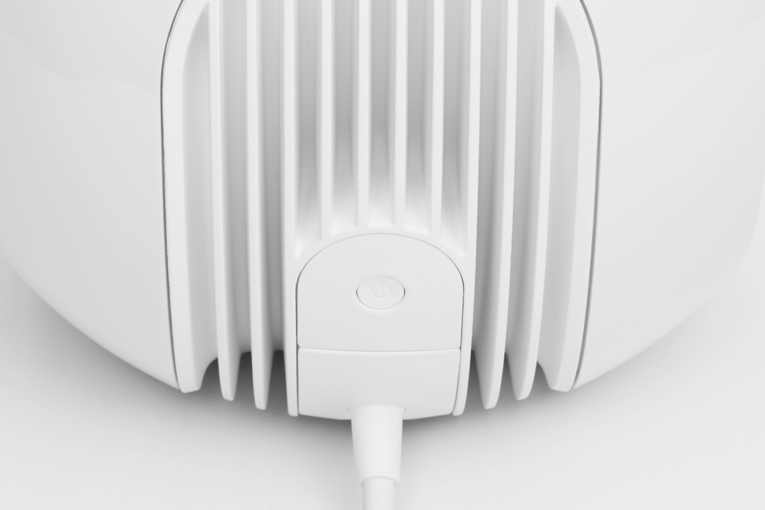
All Phantoms are the same size -- about 10”H x 9.9”W x 13.5”D -- and feel solid and are fairly heavy, at 25 pounds each. Their space-age design makes the Phantoms look decidedly different.
Each Phantom model has two 6.5” woofers and one 5” midrange driver, all with convex aluminum diaphragms. The woofers are mounted on the sides, directly opposed to cancel out non-music-signal vibrations. This is an application of Newton’s third law of motion: “For every action, there is an equal and opposite reaction.” Because of the woofers’ opposing forces, vibrations caused by them cancel out. As in the other Phantoms, the Gold’s woofers have tremendous excursion -- more than 1” -- which the company likes to show off in demos by pumping bass-heavy music or test tones through them at high volume. The midrange is on the front, and the tweeter is placed at its center, in a concentric or coaxial arrangement -- that is, the two drivers share the same radiating axis. The Gold Phantom’s 1” titanium-dome tweeter is claimed to extend up to 27kHz; the Phantom and Silver models have aluminum-dome tweeters specified up to 25kHz.
The speakers are white, but the side panels are plated in 22K gold. Although the Gold Phantom is capsule-shaped, it sits securely on a flat base toward the speaker’s rear, which allows it to be placed on a shelf, table, or stand, and point slightly up toward the listener.
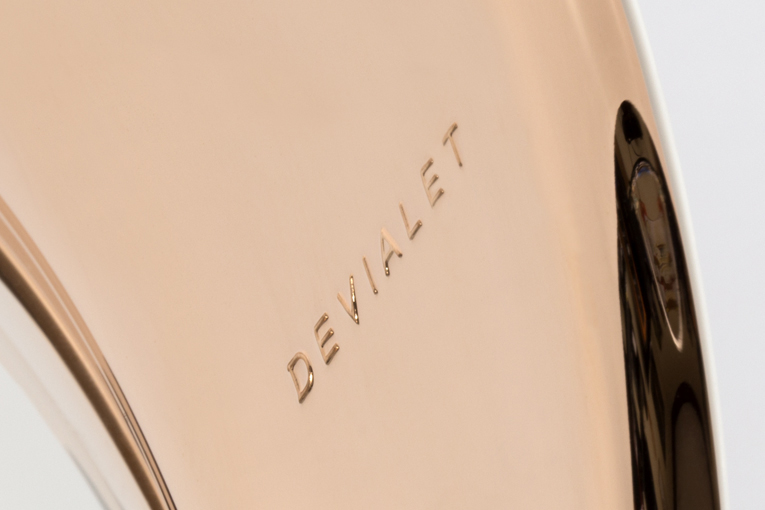
All Phantoms rely on Devialet’s proprietary Analog Digital Hybrid (ADH) amplifier technology, which they pioneered in 2010 in their groundbreaking D-Premier amplifier. ADH comprises class-A and -D amplifiers operating in unison, and is claimed to deliver the sweet, musical sound audiophiles attribute to class-A amps with the dynamics and efficiency of class-D amps. In the Phantoms, ADH is brought down to chip size, to fit into these compact enclosures. Devialet claims that the Phantoms’ smaller, chip-based amps nearly match the measured performance of their standalone amplifiers.
The performance specifications for the standard and Silver Phantoms border on the incredible; for the Gold, they’re even more so. Each Phantom has three amplifiers: one each for the tweeter, the midrange, and the two woofers. The individual output powers of these amps aren’t specified, but Devialet says that the Gold’s total peak output is 4500W, and that it can produce a maximum sound pressure level of 108dB at 1m, compared to the standard Phantom’s 750W/99dB SPL and the Silver’s 3000W/105dB. The Gold is also claimed to play deeper -- down to 14Hz, vs. 16Hz for the standard and Silver (all bass specs are -6dB). Of course, with two relatively small 6.5” woofers in a compact enclosure, none of the three models can deliver these subsonic bass frequencies at high levels. For all three models, the frequency response is specified as 20Hz-20kHz, +/-2dB -- if that’s accurate, it’s incredibly broad and linear for speakers this small.
To achieve such specs, more-than-cutting-edge enclosure and amplifier design are needed. The Phantoms heavily rely on digital signal processing (DSP), including the use of their proprietary Speaker Active Matching (SAM) technology. All three speakers basically have tiny computers inside, crunching digital data that include equalization to extend the bass response and linearize the frequency response. The DSP also limits output; unlike with most passive speaker designs, you can play any Phantom loudly without risking damage to its drivers.
Although their ads don’t say so, I was told by a Devialet rep that the Gold Phantom includes far more sophisticated DSP than its predecessors; apparently, the outputs and bass response aren’t the only things improved.
Because all three Phantoms rely on digital horsepower, it makes sense that they accept only digital signals: Bluetooth, Wi-Fi, optical, and Ethernet (wired or over the powerline). PCM signals of resolutions up to 24-bit/192kHz are accepted, but not DSD (though Devialet’s standalone amps do support DSD64). There is a digital-to-analog conversion stage just before amplification. The standard and Silver Phantoms have Texas Instruments PCM1798 DAC chips, but the Gold has a “Devialet DAC embedded in ADHV2 intelligence” -- ADHV2 being the latest generation of ADH amplifier technology.
Setup: from stands to single to stereo to Spark
Devialet offers three stand options, all of which give any Phantom model a unified look, from the tops of the speakers to the floor. The Tree ($750/pair) and White Tree ($698/pair) stands are both 26” high and attach to any Phantom. The difference in price is due solely to the finish of the center column -- the White Tree’s is all white, while the Tree’s has a wood-type wrap. Both come with power, optical, and Ethernet cables that can be routed through the column, meaning no dangling wires. The Treepod ($658/pair) has three wood-finished legs, stands only 16.7” high, and includes no wires. The height of the Trees makes them probably better for sound quality; the Treepod looks a bit too low for serious listening, and more like a fashion item. There is also the Gecko wall bracket ($398/pair).
I used 24”-high, all-metal Foundation stands set 9’ apart -- almost 2’ wider apart than is usual for speakers in my room -- with each Gold Phantom about 8’ from my listening seat. This gave me a wide soundstage -- pulling the Devialets a foot or two closer together didn’t improve their imaging precision, as it does with most speakers in my room, so I left them where they were.
At first I tried listening to the Gold Phantom in a way that Devialet has promoted since the beginning, presumably if you can’t afford and/or don’t have the space for two: in mono, using just one speaker. But while I admired a single Gold’s clean sound, deep bass, and high output, I wasn’t thrilled with music in mono. I value the spaciousness, imaging, and instrumental separation that two or more speakers can provide. I found only one benefit: A single Gold Phantom can be controlled directly with a smartphone, tablet, or computer running only Devialet’s app, Spark, which is free and available for Windows, OS X, iOS, and Android operating systems (see below).
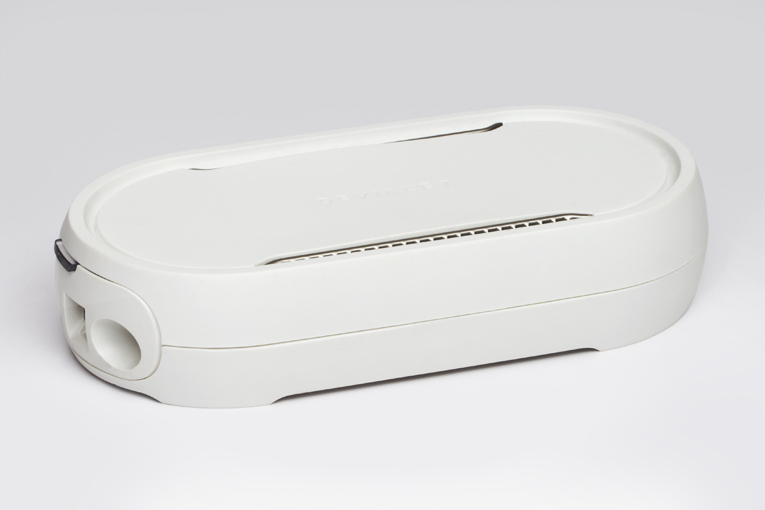
I did all the rest of my listening in stereo. But if you want to run two or more Gold Phantoms -- up to 24 can be configured into a system -- you’ll need to do as I did: hook up Devialet’s Dialog network box ($329), a small router controlled with the Spark app. For all the Dialog does, it’s cheap. You plug it into the wall and it automatically sets up its own network -- Ethernet over your household powerline (often called powerline networking, or PLN) and Wi-Fi. There’s no setup procedure or even a password -- plug the Dialog in and, presto, a Devialet-dedicated network is there, and all Phantoms are automatically found. The advantage of having the speakers run on their own dedicated network is that their signals can’t be affected by heavy traffic from other networked devices, such as printers and NAS drives, and it’s much easier to achieve precise synchronization. All you have to do is connect the Dialog to the main router in your house with an Ethernet cable, which is what connects it to the Internet and gets you to streaming services for music -- and to Devialet HQ, in France, for updates. In my setup, PLN and Wi-Fi worked well.
If the Dialog doesn’t find all your Phantoms automatically, let Spark know -- the app will then guide you through a clever process that involves finding and configuring each Phantom by sight and touch and sound: you look around, choose a Phantom, then walk over and place a hand atop it; it responds by vibrating, to indicate that the Dialog knows you’ve found it, and programmed sounds then indicate the speaker’s status: e.g., powered on, or having been found by the Dialog. The Dialog “lost” my Golds a few times during the listening period, but using this procedure, Spark and I found them again every time. Once Spark and the Dialog have identified the Phantoms, you can assign them as mono channels or stereo pairs, and/or as denizens of different rooms.
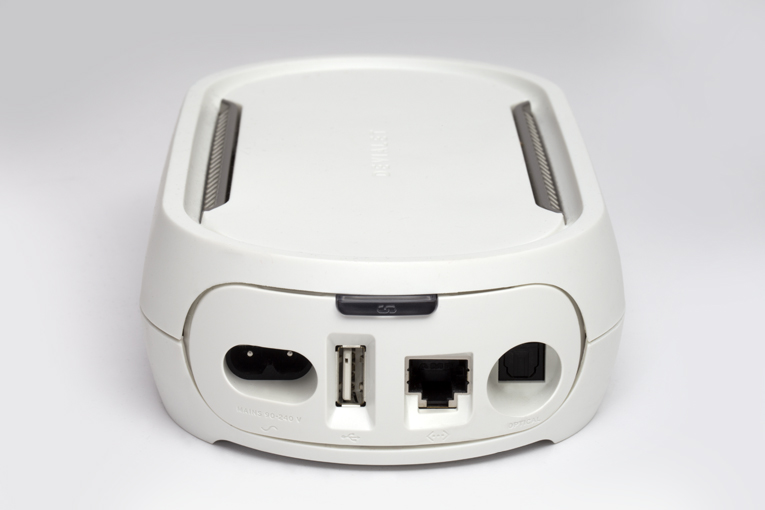
I used Spark on my Samsung Galaxy S5 and S8 smartphones and on my Windows laptop, handling not only setup but also volume control and music selection. I found it highly intuitive and responsive -- pressing an onscreen control had an almost instantaneous effect. Spark let me easily connect to Tidal, and supports Deezer, Qobuz, Spotify Connect, Apple AirPlay, and Internet Radio. Devialet also does a good job of sending out upgrades -- six came in while I had the Golds -- via the Internet and Spark to the Phantoms and Dialog. You won’t necessarily know what’s been upgraded, but from time to time I’d see new options appear -- such as Live on Phantom, a Devialet-owned service for streaming live music events. Very cool!
Spark’s main flaw is its lack of support for network-attached storage (NAS) for all host devices other than my laptop. This was a hassle -- my music is stored on NAS drives. With Spark installed on my laptop, I could point the computer at my NAS and play the songs from there, which worked well enough. But those who use only a phone and/or tablet will find this a deficiency in an otherwise very good app. Perhaps an upgrade will fix it.
Sound
During my 2014 visit to Devialet, a rep told me that when developing the first Phantom and Silver Phantom, the company’s performance benchmark had been a floorstanding speaker that was popular at the time and retailed for about $40,000/pair. This wasn’t to make the Phantoms direct competitors of that model, but to set a goal of genuine sound quality that they believe they met. A farfetched and outlandish claim?
I told Spark (loaded on my computer) to cue up from a NAS device “Where Are You Tonight?,” from the Cowboy Junkies’ The Caution Horses (16-bit/44.1kHz FLAC, RCA). I was immediately taken with how precisely Margo Timmins’s voice was positioned at the center of the soundstage. I didn’t have to close my eyes and concentrate to better focus the image of her voice -- it was rock solid and unwavering in space, regardless of the volume level, as if she were right there in the middle of the room, all without her voice ever sounding unnaturally large.
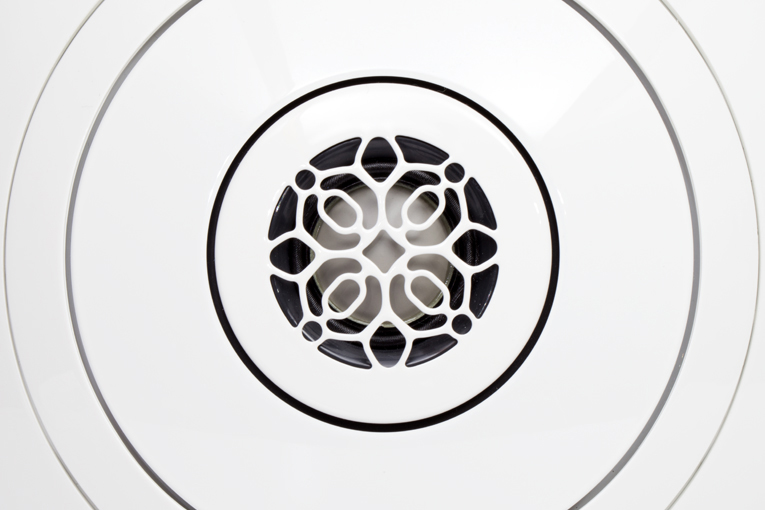
Hearing such a fine combination of image precision and soundstage spaciousness, with neither sacrificed to the other, I next listened to “Misguided Angel,” from the Junkies’ previous effort, The Trinity Session (16/44.1 FLAC, RCA), also from NAS. Once again, hyperprecise image specificity -- not only of Margo’s voice, but of her brother Michael’s, a little to one side and behind her, and the various acoustic instruments placed precisely on the stage. Behind them, the ambience of the large church this album was recorded in seemed to vastly expand my already large listening room. With these and other recordings, I learned that, as long as the recording has captured them, two Gold Phantoms can produce precise images and wide, deep stages better than almost anything else I’ve heard.
I then went to Spark on my phone, opened Tidal, and streamed “Pacing the Cage,” from Bruce Cockburn’s The Charity of Night (16/44.1 FLAC, True North). Image placements were just as precise: his voice rock-solid at center stage, his acoustic guitar to the left. But I noticed that the separation of voice and guitar was more distinct than I’d heard before. I played the track several times, to make sure I was hearing what I thought I was hearing. I was -- that greater separation of voice and instrument was me hearing deeper into this very familiar recording than I ever had before. I then went back to The Trinity Session to listen more closely to little details, and again found the Gold Phantoms unveiling as much or more musical information than I’d ever previously heard.
I was surprised that the Gold Phantom’s high resolution didn’t seem to be the result of bumping up certain frequencies to create a heightened but artificial sense of detail. Instead, to quote Hans, I found the Gold Phantom’s sound “broadly neutral” -- that is, fairly linear throughout the audioband, but not as ruthlessly neutral as, say, Revel speakers. I’ve reviewed Revel’s Ultima2 Salon2 ($21,999/pair) and Performa3 F206 ($3500/pair), and found their sounds as accurate as accuracy gets. But in the midrange, the Gold Phantom sounded ever so slightly recessed -- not laid-back or too relaxed, but definitely not in my face. For example, Cockburn’s and Margo Timmins’s voices were rock-solid between the speakers, but a few inches back from where a Revel would place them.
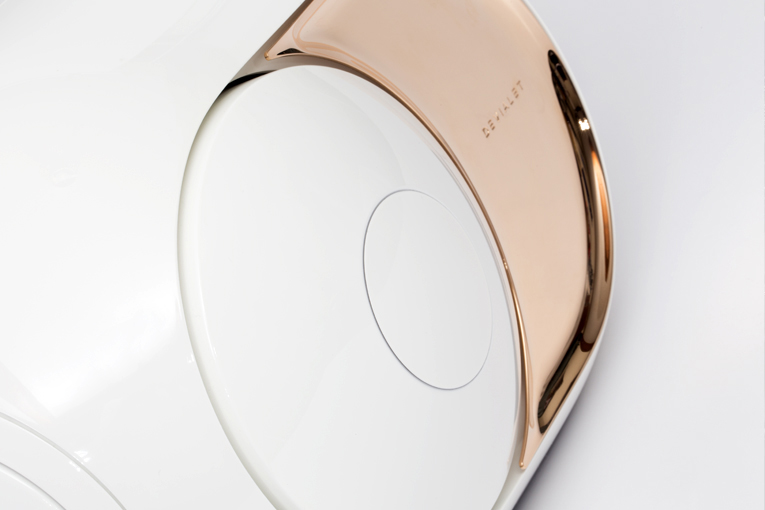
I also found the Gold Phantom’s extreme top end a touch subdued. It sounded very clean overall, but not quite as extended as I’ve heard from the very best speakers I’ve had here in the last two years -- for instance, KEF’s Reference 3 ($13,999.99/pair), which I had in for review during the same period, often playing side by side with the Gold Phantoms. The KEFs had highs that were not only a bit more extended, but also a touch airier and a smidgen sweeter. That said, since the Reference 3 is a passive design, it needs electronics and cables to make it work -- and in my system, those components added up to more than $50,000. The Gold Phantoms never sounded dull in my room -- but they also never sounded bright.
At the other end of the audioband, The Trinity Session trained a spotlight on another Gold Phantom strength -- its astoundingly deep and controlled bass. When the Phantoms were first announced, many doubted that such small speakers could produce the deep-bass output Devialet claimed. But in a demo of the original Phantom I attended in Paris, I heard lows that I could have sworn were coming from a subwoofer -- or two. However, the bass I heard there wasn’t as tight as I’d have liked, and later, Hans told me that the Silver Phantom’s bass was a bit too fulsome and overpowering for his room -- he was having trouble with room modes being excited, and wished they’d provided a tone control to reduce the low end.
My experience was far different. This might be because my room is much bigger than Hans’s -- 36’L x 18’W -- or because the Gold Phantom’s bass is better controlled than the Silver’s. Whatever the reason, with the Gold Phantoms I heard bass that extended to below 30Hz without the woofers bottoming out. There was no hint of overloading my room at lower or upper bass frequencies, even with a recording like The Trinity Session, which has powerful bass output that extends down to 20Hz -- which the Golds reproduced. Nor did all that bass output ever overshadow or interfere with the midrange, as I’ve heard happen with some bass-heavy speakers. What’s more, the transition of the output of the woofers to the midrange was as seamless as I’ve heard. Regardless of the kind of music I played, rock or classical or folk, I could never tell where woofers and midrange or midrange and tweeter handed off to each other. The Gold Phantom’s coherence throughout the audioband was superb.
The Devialets’ bass output was also projected more powerfully than that of any other small speaker I’ve heard -- and even of many large ones. Moments before writing this, I streamed “Baba O’Riley,” from the Who’s Who’s Next: Deluxe Edition (16/44.1 FLAC, Decca/Tidal), at a fairly high volume. At 0:46, Keith Moon’s drums kicked in with the kind of clarity and impact I’d expect from speakers many times the Gold Phantom’s size -- yet with no hint of compression or restraint. Hans found that he could make the Silver Phantoms’ woofers compress, but he tends to play lots of electronic music, with low-frequency tones generated by computers rather than by acoustic or even electric instruments. With recordings of acoustic instruments, I could never compress the Golds’ woofers. That’s not to say that the Gold Phantom was the last word in bass depth and power -- KEF’s Blade Twos ($25,000/pair) still produced the deepest, most powerful, most satisfying bass I’ve heard in my room. But for its size and price, the Gold Phantom’s bass was impossible to fault.
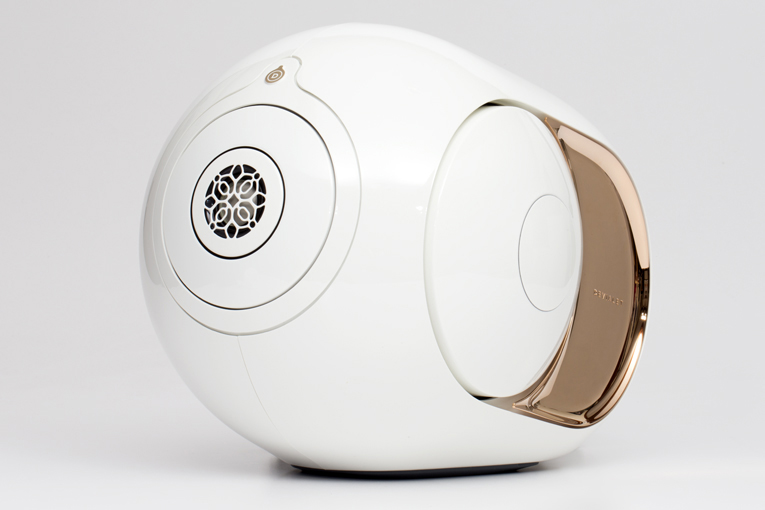
I knew that playing “Baba O’Riley” pretty loud wasn’t enough to test another Devialet claim -- the Gold Phantom’s ability to play extremely loud with “zero distortion.” To do this, I first used the Gold Phantoms to compare Tidal streams of original and remastered versions of the Tragically Hip’s Fully Completely (both 16/44.1 FLAC, MCA). “At the Hundredth Meridian” is a ballsy, bluesy, fast-paced rocker, but its original 1992 release sounds thin, dynamically constrained, bass-shy, and anemic compared to the remaster. I cranked the remastered version up to SPLs far louder than I’d ever use for listening -- using my RadioShack SPL meter, peaks of 98-100dB at my listening seat. The sound through the Devialets remained visceral, dynamic, and clear.
When I pushed them a little further than loud or even Loud, to flat-out LOUD, the sound remained clean and the bass was still deep and well controlled. But the dynamics through the midrange and highs were becoming constrained, and I could sense that the DSP engine was limiting the SPLs at certain frequencies to keep the drivers from being overdriven. Despite the limiting, the sound always remained exceedingly clean -- I can’t dispute Devialet’s claim that the Gold Phantom exhibits very low distortion no matter what level you play them at, because the DSP won’t let you drive them into distortion. In contrast, Vivid Audio’s Oval B1 Decades ($28,000/pair) and KEF’s Blade Twos could, when driven by an appropriately powerful amplifier, play a little louder in my room and not sound dynamically constrained at comparable levels. So, as with its bass output, the Gold Phantom’s maximum volume isn’t the be-all and end-all. But I’m sure a pair of Gold Phantoms will easily play loudly enough for most people -- and then some.
Conclusion
My biggest complaint about Devialet’s Spark is that it doesn’t support NAS devices through smartphones and tablets; otherwise, I found it an excellent app. The Gold Phantom’s top end lacks some air and sweetness, but the speaker’s strengths far outweigh that weakness: In my room, the pair of them delivered surprising clarity and coherence across the audioband, astoundingly deep and controlled bass, reference-class soundstaging and imaging, and extremely high output. And to have all of this not only at a reasonable price, but with such ease of use and setup and features, makes a pair of Gold Phantoms with the Dialog a compelling option not only for those who want something that sounds great and is small and rich in features, but also for the audiophile who cares only about sound quality. And when I say “sounds great,” I don’t mean “for the money” or “for a small speaker” -- the Gold Phantom sounds great, period.
A year or so after the original Phantom models were introduced, a friend who works for a different audio company said to me, “For $5000, there’s nothing nearly as impressive today as a pair of Silver Phantoms.” I smiled and said, “Hmmm, that’s interesting.” But I never asked him what had so impressed him about their sound. Now, having lived for many months with these new Devialets, I think at last I know what impressed him, because I feel the same way and can say almost the same thing: For $6309, there’s nothing nearly as impressive today as a pair of Gold Phantoms with Dialog.
. . . Doug Schneider
das@soundstagenetwork.com
Associated Equipment
- Speakers -- KEF Blade Two and Reference 3
- Preamplifiers -- Audio Research G-Series GSPre, EMM Labs Pre2, Simaudio Moon Evolution 740P with 820S power supply
- Power amplifiers -- Blue Circle Audio BC204, JE Audio VM60 (monoblocks), Simaudio Moon Evolution 870A
- Digital-to-analog converter -- EMM Labs DA2, Hegel Music Systems HD30
- Computer -- Samsung laptop running Windows 10, JRiver Media Center 20, Roon
- Digital interconnect -- AudioQuest Carbon USB
- Analog interconnects -- Crystal Cable CrystalConnect Standard Diamond
- Speaker cables -- Siltech Classic Anniversary 330L
- Power cords -- Shunyata Research Venom HC
- Power distributor/conditioner -- Shunyata Research Venom PS8 with Defender (2)
Devialet Gold Phantom Loudspeakers
Price: $5980 USD per pair; $329 for Dialog.
Warranty: Two years parts and labor. Devialet Care extended warranty, $299: three years, replacement of two Gold Phantoms, $249 each instance.
Devialet SA
6 Rue Ménars
75002 Paris, France
Phone: +33 9-75-18-67-60
Website: www.devialet.com






















